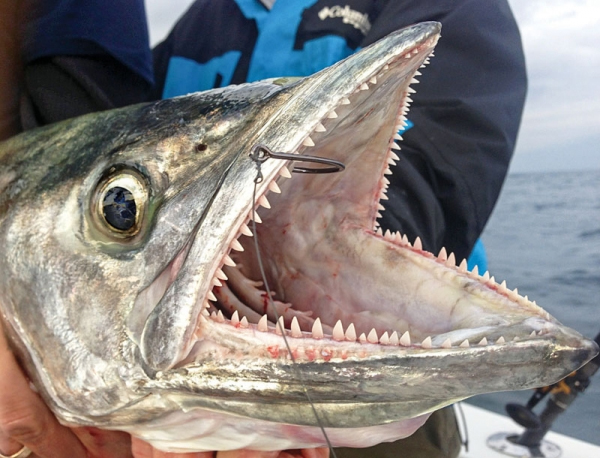
Metal Logic
Metallic leaders are often necessary to avoid cutoffs from Spanish and king mackerel, bluefish, wahoo, �barracuda and sharks. Photo by George Poveromo
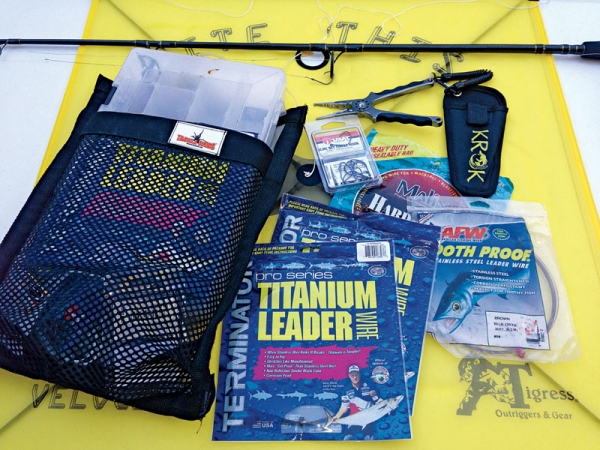
Metal Logic
Wire prep: Regardless of the type of metallic leader material you choose to employ, pre-rigging keeps you in the game when the bite is on. Photo by George Poveromo
We were on a roll, having bested a sailfish double-header under �lackluster conditions. After Bill Harpling and Steve Grigsby both released their first-ever sailfish, we ran inside, anchored over a ledge in 35 feet of water, hung a block of chum over the gunwale, and began pitching out live pilchards to draw in Spanish mackerel.
Harpling's luck continued, as a big kingfish blasted his blue runner under a �balloon float. I was a bit concerned about the 10-inch trace of 20-pound-test Terminator �titanium leader, but he boated the king, and on post-battle inspection, the titanium leader looked like new.
Metallic leaders are often necessary to avoid cutoffs from Spanish and king mackerel, bluefish, wahoo, �barracuda and sharks. And like fabricating any piece of terminal tackle, the trick lies in selecting the leader material and strength that will draw the most strikes, and remain intact for the duration of the fight. Given the choices of single-strand wire, Sevenstrand, Steelon (nylon-coated Sevenstrand), and premium-priced titanium, which is really the best for large, nearshore toothy pelagics on light tackle?
Titanium
Regarded as the 'fluorocarbon'� of metallic leaders, titanium costs the most. �However, its diminutive diameters minimize its visibility, and it is more kinkproof and �cutproof than other metallics. Single-strand nickel titanium does have some stretch, and is therefore more forgiving (advantageous with lighter strands). It is also quick to rig using clinch and Albright knots.
I've known about titanium since it entered the market, but was exposed to it only last year by Capt. Skip Dana of Pompano Beach, Florida, an �accomplished tournament competitor and owner of the Fish City Pride drift boat. We used it during a TV shoot, and did very well on sailfish and kingfish, one of which weighed 42 pounds. Since my initial experience, I've favored titanium over light single-strand when live-baiting.
'Titanium is toothproof, and it doesn't corrode,'� says Dana, 'I've had titanium leaders on kingfish jigs for a couple of years, and they're fine. When we tournament fish, seconds count; after a catch, we strive to get a fresh bait back out immediately. Single-strand wire is time consuming to rig, but I can fabricate a titanium leader in seconds. And nine times out of 10, it's fine after catching a fish; it doesn't kink or get those curlicues like the single-strand wire usually does.'�
Days before this writing, Dana scored an 85-pound wahoo on a live �goggle-eye using a 30-pound-test �Terminator titanium leader. 'The hook was down the wahoo's throat,'� said Dana. 'We pulled it out, and rebaited using the same hook and leader; the titanium leader was fine.'�
Dana uses around 3 feet of 40-pound-test Terminator, and an 80-pound Spro swivel to join the �titanium leader to his �nonmetallic �wind-on leader. He uses in-line circle hooks exclusively, and has been �experimenting with �dropping to 30-pound-test titanium with good results and no bite-throughs. Even his vertical jigs utilize �titanium leaders.
As much as I use and rely on titanium, I have to say, bulky knots are the norm (though they'll hold, the knots won't fully cinch down). Also, tag ends can't be simply and cleanly broken off, as with single strand.
Sevenstrand
Revered for its flexibility and �immunity to kinking, Sevenstrand wire '’’ composed of seven strands of twisted �stainless steel '’’ has a round profile, making it conducive to sleeving and crimping.
Freeport, Texas-based pro, Capt. Carl Christoph has a reputation for catching big fish. He swears by �60-pound-test Sevenstrand leader. 'I can quickly tie up a bunch of live-bait king mackerel rigs and store them,'� says Christoph. 'They'll last a long time, won't kink, and I've yet to have a fish bite through one. I prefer to snell my hooks, especially my stinger leader. I often snell my lead hook to the leader, and sometimes sleeve and crimp it. And I can trim any tags, which could snag weeds. My most productive rig is a No. 1 or No. 2 single hook '’’ one small enough to stay latched to the fish's nose, and a 4x-strong treble hook for my rear stinger.
'With crimping, nine times out of 10, you'll be fine,'� says Christoph. 'But sometimes, the wire slips through the sleeve, and you'll lose a fish if you're not careful. To prevent this, rather than neatly cutting the tag end by the sleeve, flatten the end; it will be nearly �impossible to pull through.'�
Nylon-Coated'� Sevenstrand
Capt. Mark Schmidt of Key West, Florida, prefers 12 inches of 30-pound-test nylon-coated Sevenstrand '’’ commonly referred to as 'Steelon'� '’’ for a variety of toothy species common in his waters. For cero and Spanish mackerel in clean water, he opts for 20-pound-test, and for king mackerel, 45-pound-test. Schmidt cites the material's flexibility and suppleness that allow for quick and easy fabricating. He also acknowledges that the nylon finish of the material diminishes any shine or glare in the water. For sharks, he upgrades to 80- and 120-pound-test, and really appreciates the nonkinking material. Schmidt uses a figure-eight knot to attach the hook or lure, and an Albright knot to join the leader to his running line, or wind-on nonmetallic leader.
'Now, if I'm live-baiting offshore for sails, and where a big king or wahoo is a possibility, I'll switch to 55- or 60-pound-test single-strand wire, with a small swivel to attach it to my fishing line,'� says Schmidt. 'I believe single-strand is a bit harder for fish to notice, and its slick finish slides right through their jaws for unobstructed hook-sets. Only two problems: Single-strand rigs are time consuming to fabricate, and they can kink and break. They're shot after one fish. I'll rig a bunch in my spare time, and keep them ready to go.'�
Potential negatives of nylon-coated Sevenstrand include trapping salt in the coating (from nicks) that ultimately weakens the strands, the possibility of teeth nicking a single strand or two '’’ which may go unnoticed and �ultimately fail '’’ and slippage through sleeves if the tag end isn't flattened out or knotted.
Good Ol' Single-Strand
Dave Workman Jr. helped revolutionize competitive king mackerel fishing. His favorite metallic leader? 'Single-strand wire, hands-down,'� says Workman. 'Yes, it can kink; so just change out the leader after each strike. Single-strand offers a lot of stealth, if you know a trick or two about selecting the wire.'�
Workman advises sorting through various packages of single-strand for the darkest wire. 'Depending on the manufacturing process, some batches of wire are darker than others, and that's what you want '’’ that darker brown or almost purplish wire,'� says Workman.
It blends in better in tannic and dirty water, and doesn't give off as much reflection that might tip off fish. �Workman opts for No. 4 (38-pound) wire leader, and No. 6 (58-pound) for the stinger-hook leader. For �outsize kings in the Gulf of Mexico, he upgrades to No. 7 (69-pound) wire. Workman also advises to slowly make the haywire twists (he'll do five) and barrel wraps (he'll make two), since rapidly doing them heats up the wire and weakens it.
Getting dialed in with the hot leader setup for any particular day often comes down to experimenting. Drop down in size, and vary leader material. You just might discover that the fish are indeed biting '’’ once you find the leader that fools them.
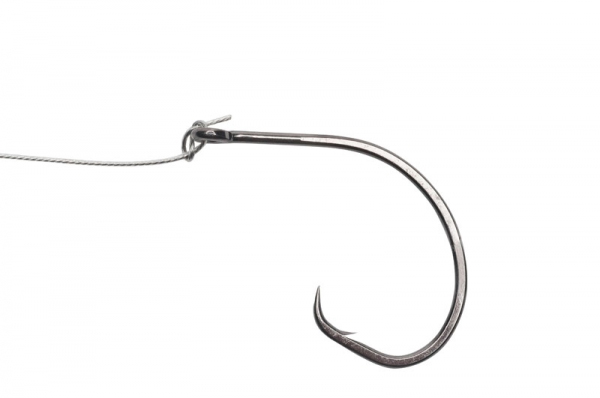
Metal Logic
Titanium: Clinch knots can be used to attach titanium leaders to hooks.
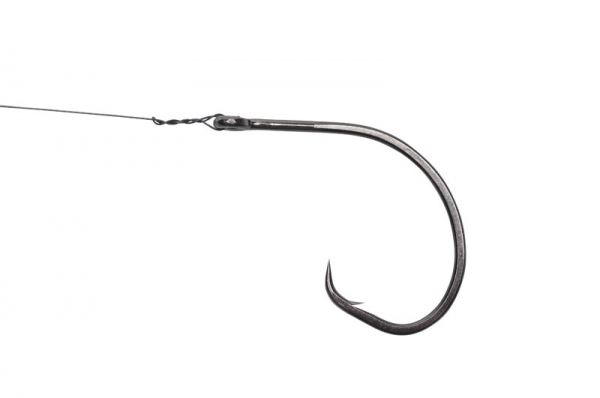
Metal Logic
Sevenstrand: Virtually toothproof, Sevenstrand wire requires sleeves and crimps.
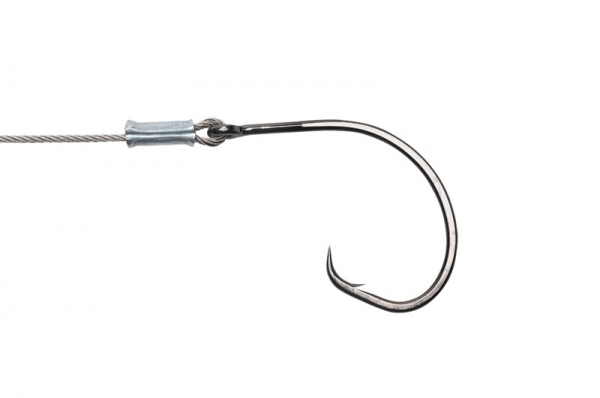
Metal Logic
Nylon-Coated Sevenstrand: Figure-eight knots work well with nylon-coated Sevenstrand wire.
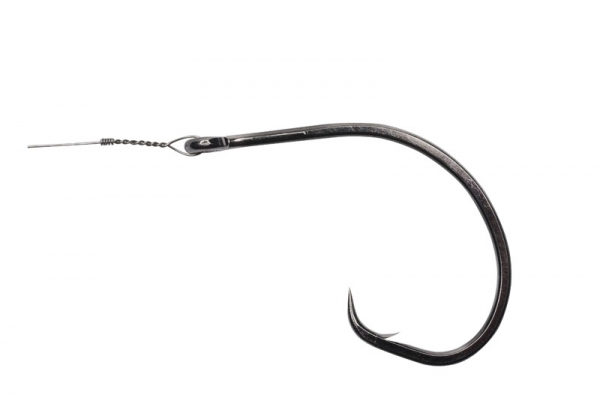
Metal Logic
Single-Strand: A carefully tied haywire twist works best when using single-strand wire.

